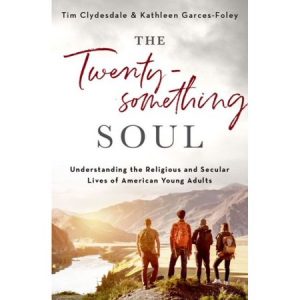 One of the books I’ve read recently that I know I’ll return to many times in the years to come is The Twentysomething Soul: Understanding the Religious and Secular Lives of American Young Adults (Oxford University Press, 2019) by Tim Clydesdale and Kathleen Garces-Foley. This comprehensive appraisal of the contemporary experience of twentysomethings offers unparalleled insight into the religious experience of this age group in the United States.
One of the books I’ve read recently that I know I’ll return to many times in the years to come is The Twentysomething Soul: Understanding the Religious and Secular Lives of American Young Adults (Oxford University Press, 2019) by Tim Clydesdale and Kathleen Garces-Foley. This comprehensive appraisal of the contemporary experience of twentysomethings offers unparalleled insight into the religious experience of this age group in the United States.
The Good News
To help readers appreciate the vast number of American twenty-somethings who are religiously affiliated, the authors write, “there are more twentysomethings affiliated with the Protestant and Catholic faith than there are persons of any age residing in the state of Texas” (p.198).
With some 26.5 million persons in this category, Protestant and Catholic twentysomethings would fall between the nation’s most populous state: California (38.3 million) and the nations’s second most populous state: Texas (26.4 million).
The Mainline Reality
Today there are some 6.0 million twentysomethings affiliated with Mainline Protestant traditions (p.198). This group would fall between the seventeenth most populous state: Tennessee (6.5 million) and the eighteenth most populous state: Missouri (6.0 million).
The present reality, however, isn’t stable. Based on their extensive research, Clydesdale and Garces-Foley find:
Unless some larger social disruption prompts hordes of conversions to Mainline churches in specific, or something triggers a distinctively Mainline spike in fertility rates, we expect a 40% decline in twentysomethings affiliated with Mainline Churches by the latter part of the 2040s (p.132).
So What?
Today, 14% of American twentysomethings are Mainline Protestants (p.103). Just over 1/3 of these young people (35%) attend worship at least twice a month (p.103). Community is the number one reason these young people choose to affiliate with a congregation (p.112).
Given that the Mainline Protestant tradition is far older than the American population, projections showing a 40% decline in twentsomethings over the next thirty years is troublesome. Clydesdale and Garces-Foley close their chapter on Mainline Protestantism by noting the impact of the rapid decline in twentysomethings will result in an increasing number of congregations closing their doors.
- If you are part of a Mainline Protestant congregation today, what does your congregation’s twentysomething ministry look like? What percentage of your congregation falls into this age cohort?
- Short of a huge wave of converts or a dramatic increase in fertility, what else do you think might lead the decline of twentysomethings to be less radical than the 40% asserted by Clydsedale and Garces-Foley?